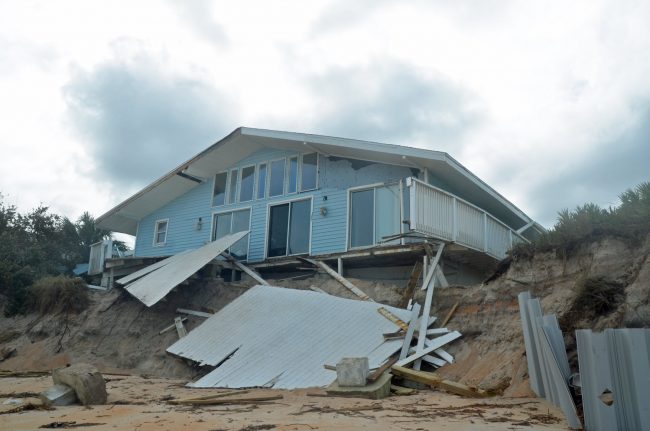
There is destruction we’ve all become familiar with after Hurricane Matthew: downed power lines, ripped off roof shingles, mangled lanais, deracinated trees toppled on roofs, through fences, across yards. Then there’s the more brutal demolition of dunes and roads that now shears block after block of South Ocean Shore Boulevard in Flagler Beach (State Road A1A) and a portion of its northern end, closing long segments of road.
There was also the mostly peripheral damage to dozens of mobile homes at Surfside Estates in Beverly Beach, and scores of flooded houses in Marineland Acres, Sea Colony, Armand Beach and surrounding areas of the Hammock. The houses seem intact, but were turned into swamps of sand, sewage and brackish waters within, ruining more than furniture, carpets and paint: there are certain things insurance claim “adjusters,” as they not quite accurately call themselves, can’t measure.
But at least two devastated areas have received little attention until now, because they’re not easily visible. In one case—the houses along Painters Hill, just south of Varn Park—you’d never know there was anything wrong, looking at the structures from State Road A1A. They’re all there, seemingly unharmed by the storm. But they’re not unharmed. In the other, at Washington Oaks Garden State Park, there are only hints of the destruction if you just travel A1A, though in fact the dune breach by the ocean there was the source of much of the flooding that soaked that section of the Barrier Island, and soaks it still in several places. And that dune breach remade what was once known as Washington Oaks park on the beach-side.
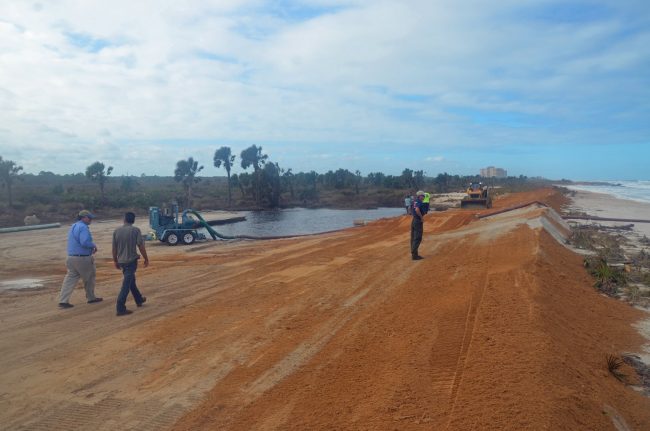
It’s destruction. There’s no other word for it. Walls of water have remade the landscape, tearing away the character of the park’s beachside acres. The same wall of water tore away masses of dunes and rendered between half a dozen and a dozen houses in Painters Hill uninhabitable. Those houses hang, cliff-like, over what’s left of the dunes the ocean devoured.
Hurricane Matthew’s storm surge was so severe in the Hammock and to its north that it ripped across the island in tsunami-like waves before surging back the other way, drenching and flooding the island on the way to the Intracoastal and back. The surge essentially dug something close to an inlet at Washington Oaks, demolishing everything in its way.
The wooden walkway that took visitors from the parking lot to the beach, above the dunes? Gone. Not a trace. The parking lot itself is half gone, excavated: the cascading waves dug an enormous crater in the northern half of the parking lot on their way to inundating the rest of the island. The asphalt just stops in serrated contours, much like it does on A1A where the ocean cut the road, and hangs there, above water. The palmetto-covered dunes that had seemed like a gentle, natural barrier between sea and island? Gone. And those rust-colored coquina boulders that had given the beach at Washington Oaks its unique, otherworldly charm? Gone. Either buried beneath or scattered somewhere, out of context.
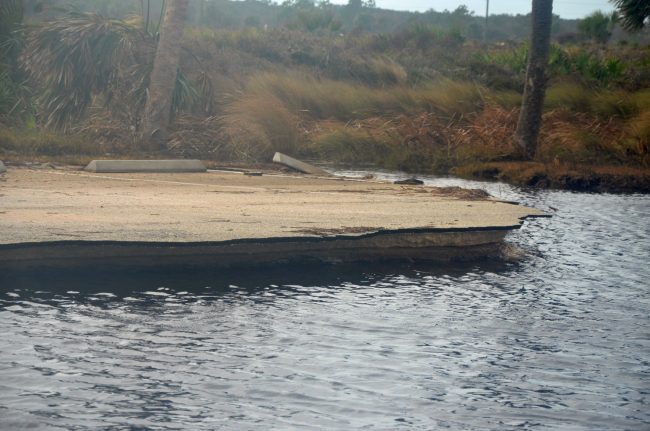
Late this afternoon a small dozer was finishing what had taken days to build: a makeshift, artificial barrier of packed sand to stop the ocean from flooding the island again, as a giant pump sucked water out of the parking-lot lake and dumped it into the ocean, spraying the area with the unmistakable stench of effluent. County and state workers have been working frenetically there to rebuild the barrier and prevent an aftershock of a disaster as the ocean tides have been rising again, courtesy of Hurricane Nicole a long distance off.
“We’ve closed off the main new breach and we closed off the ditch going southward, but both of those could be washed off,” County Administrator Craig Coffey said this morning. “Essentially it’s packed sand so it’s not super strong and it’s not comprehensive, meaning there’s other areas that’s threatening to breach north.” He described what had happened at the height of the storm in the area, and the river-like disaster workers are trying to prevent now: “If you think on the other side of a dune, it’s like almost a big lake, so the ocean comes in, fills that up, then that bathtub goes to the Intracoastal through Washington Oaks or it comes southward. So our fear is that it opens back up and we re-flood all the neighborhoods we have been pumping for days and working not to flood.”

That’s Marineland Acres, it’s Sea Colony, it’s Malacompra Road and Armand Beach, along with numerous smaller subdivisions in between.
The weather conditions have not been helping. The heightened tides, Coffey said, referring to a tunnel-effect between a high and low pressure systems, are “hitting in our area between Daytona all the way up to Jacksonville, because of the concentration. As Nicole starts to go off, Friday, Saturday, Sunday, we’ll be a little better, so you’re getting secondary effects from Nicole, not primary effects. But the problem is every day that goes by, the tide is getting higher and higher. Between Tuesday and Saturday it was a foot higher just on the tide charts. Then you start throwing in the wind and hurricane secondary stuff, all of that starts getting worse.”
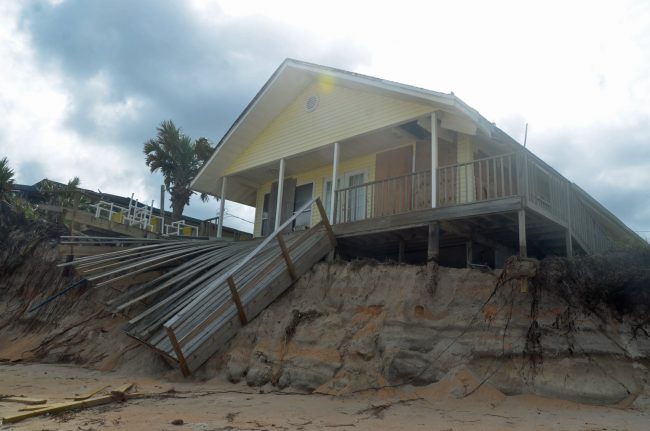
So while the rest of the county has been working to get back to normal, the situation at the northern end of the county has continued to be critical, if entirely out of view of public eyes. “We had a conference call this morning at 8:30 with all the agencies, the Army Corps, various state agencies ranging from DOT to DEP to the park service,” Coffey said, referring to the state transportation department and the state’s environmental agency. “Bottom line is, the plan we came up with is we’re going to be maintaining the breach that we filled through the next 24 hours. At that time they’re going to do a broader type of project along Washington Oaks State Park to hopefully allow it to sustain what’s going to occur over the next four or five days until a more permanent solution is put in place. They’re going to be bringing state resources, potentially federal resources, and we’ll be handing that off to them whenever they get here. We won’t be leaving our post until we can do a proper hand-off. That’ll free up our resources, we’ve got to fix all those streets. We’re starting that process now. We’re still pumping.”
But that same “concentration” effect that’s caused higher tides and pressure on the rebuilt barrier around Washington Oaks is what has continued to weaken the cliffs on top of which sit that dozen houses along Painters Hill, houses that seem ready to start crumbling beneath, where nothing but sand, if that, is left holding them up. Picture houses leaning over the cliffs of Dover, if those cliffs were made of sand (and were not as high). That’s the situation in Painters Hill for the houses at 3221 Ocean Shore, and at 3209, 3189, 3179 and 3171.
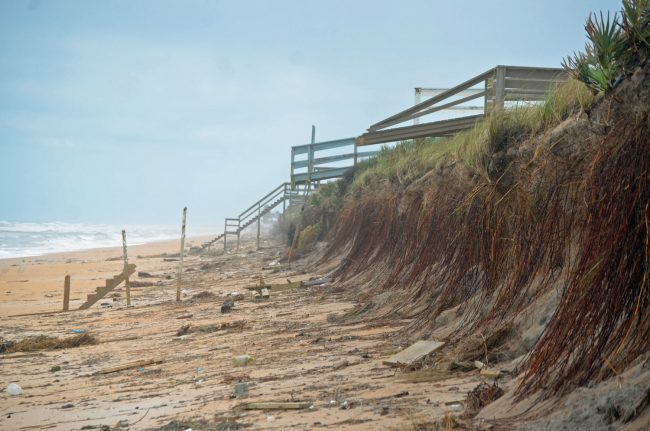
On the property appraiser’s maps, those houses have all been shaded red: destroyed. At 3215 and 3183, the houses are shaded the color of damage, but they’re not considered destroyed.
To see them from the beach is to see houses that have lost their bearings. There’s nothing between them and the ocean—not a dune, not a shrub, and for some of them, there’s only blocks holding them up, with voids beneath. Some of the house’s porches or peripheral features have collapsed. Along the wall of eroded dunes, every wooden beach access has been plundered or ripped away, leaving behind skeletal planks mimicking the stage of an absurdist play.
“We have two that we think sections of the house may go into the ocean today around high tides,” Coffey, who’d flown over the region yesterday and become dispirited by the destruction, said. “We have about eight to 10 more that are in jeopardy, because there’s no protection. Every high tide takes additional feet, gets closer and closer to their houses, so we’re trying to beg anyone that will help us determine if we can save those houses and provide some kind of protective measure.”
Some of that may be helped if the Federal Emergency Management Agency comes through with a designation enabling individual homeowners to apply for help. But as of today, that designation was a cliffhanger of its own.
In any case it did not look as if some of the houses were salvageable. No one is about to drop new foundations, walls of sand or boulders to prop them up. That’s in nobody’s immediate plans, leaving those houses, absent something not imaginable for now, to slowly, inevitably, crumble.
The video below shows those houses.
![]()
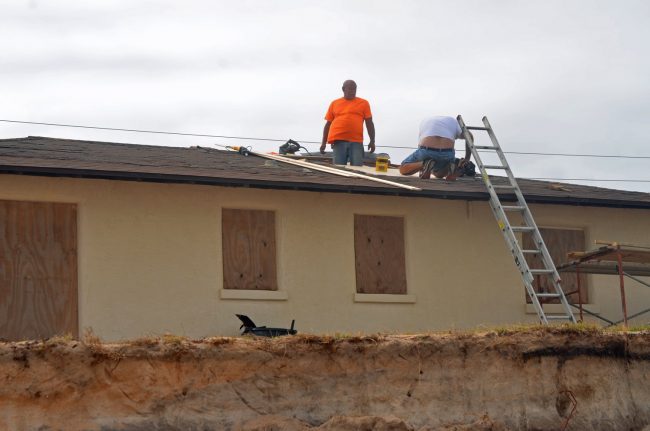






























downinthelab says
That’s why its called a barrier island.
Anonymous says
These people what more cents than sense. Why in the world would anyone ever build where they know they are risk of getting pulled out to sea? If you notice the folks with the sea wall were spared and the county should be held responsible for not mandating the sea wall when these homes were constructed. I can’t feel sorry for these people. If anything, I am angry because they are the reason the rest of us are paying out the nose for home owners insurance. You just can’t fix stupid!
Fplsux says
Good article. Washington oaks is a great local asset, can’t believe how much the storm changed it.
Anonymous says
so you wanna live on a beach?….
Been Here A Minute says
Being a Beach town sometimes requires resources going back into it, not just people going into the ocean “fun n sun”. This was just a matter of time, for years the infrastructure over there has been on borrowed time. Same with the Hammock, hope this is an eye opener.
Joe says
Hope Flagler gets the help they need, I will have to say by reading some comments following this storm I am glad I moved, there are a lot of great people in Flagler and there are a lot of very lousy one’s too, don’t miss the lousy one’s!
Eric says
Too true. A geologist will tell you that barrier islands are very transitory land-forms.
Kathy Young says
We have major damage here in Bulow Plantation, no one comes and takes pictures of our damage and posts it. Most of the folks here do not have insurance. I do but it is $2500 deductible and I lost my carport, gutters, have some water damage inside and a tree is down, just missing the house. Come on FEMA help the senior citizens out here.
tulip says
“Nature” has these barrier islands for a reason and it wasn’t to build homes on. I don’t know why barrier islands are allowed to have homes on them and, because of that there is much destruction, erosion and some of the insurance costs are passed on to people who don’t live in dangerous areas. The people that live on barrier islands or certain other coastal properties should be made to pay the entire cost of insurance. However, people will be allowed to rebuild and history will repeat itself once again.
There is a saying that you can’t mess with Mother Nature, but developers and buyers don’t seem to care.
Brian Riehle says
Very heartbreaking for those who lived there. It would be a real informative eye-opener for anyone wanting to live on the beach, (also those who don’t) if Flagler Live would, in about 6 months, do a follow-up story on the how this damage was covered by the Storm Insurance, the Flood Insurance, (and FEMA), and how the Insurance rates for these properties compare to homes in Flagler County that are not sitting on the brink of disaster.
RayD says
Not to be insensitive but have to agree with downinthelab.
Anonymous says
If you don’t build on a firm solid foundation it won’t last. That goes for homes, relationships and everything else. It should not be permitted for people to build on the coast line unless they want to self insure themselves.
Oldseadog says
Having lived for ten years many years ago on a barrier island oceanside in St. Augustine, I agree with most posters here. If you choose to live oceanside, there are costs and risks involved. You have to protect your property for catastrophic losses possible through these forces of nature through both insurance and preventative maintenance. It is wonderful to wake up each day and see the beauty of the ocean, but it is not an inexpensive setting when a hurricane hits!
gb says
Mostly wealthy owners renting out these properties for $2000 per week. Drive along A1A and see the plethora of vacation rental signs. What will these destitute people do now?
Layla says
Let’s call it what it is….most of the comments here are incredibly insensitive. Is this the kind of support the residents of Flagler show when someone experiences loss? I guess you will prefer massive hotels here, instead of private homes.
It didn’t happen to you, so you don’t care. Sad, so very sad.
Been Here A Minute says
Layla, I don’t think its about people being insensitive, it’s the disbelief that most residents in the Hammock and Flagler Beach fight any and almost all progress to help their infrastructure even after a disaster like this. You can’t have it both ways. Did you attend the meeting about the seawall or hear about the beach-sides response to it?
Shark says
I guess the taxpayers will have to shell out tons of money to fix their problem !!!!!!!!!!!!!!
Native b says
I was the person operating one of the four D6 cat dozers out on the old rock beach to rebuild the dune.To me it seems the ocean was trying to form a new inlet.We should step back and let nature run its course.Fun work for me though!One thing i know as a florida native is that you should never build your house that close to the ocean.For one example,when your house was built there you affected the natural dune and way the wind came across the dunes and palms that hold back the strong waves and wind.I wish people would stop moving here and killing our wildlife and natural beauty.
Tom says
One comment above called these posts insensitive. Yes but that is to be expected with today’s class warfare.
What is worse is how uninformed most are. First insurance. I know of no hurricane insurance that will cover the damage from erosion. Not to worry about it increasing your rates. Second about sea walls. A number of these residents wanted to put in sea walls to protect their property. The state refused their permits unless they had imminent structural damage. In other words they were not allowed to protect their property. Finally there is no way taxpayers will shell out to fix the property. If FEMA declares a disaster and SBA loans are offered they will be just that loans. In addition anyone with a vacation house does not even qualify and you also don’t qualify if you have access to other credit. So fear not your insurance premiums and taxes are safe from the rich beach livers. However the case may not be the same due to regulations, government incompetence and corruption. So go ahead and complain away about what some people have that you can’t but don’t make foolish statement that are not true.
DaveT says
@ native b; as far as stopping people from moving here I’m all for it. I was born in Ocala in 1952 and I’ve seen this state destroyed by developers from OUT OF STATE all while our state politicians caved in to PACS and special interest groups.
And to those who complain about people living on the barrier island, well natural disasters occur allover this country. Try telling that to the people of Joplin Missouri or to those burnt out by fire started by lightning and Hurricane Charlie carved up a nice path right through Fla. So I guess those people shouldn’t live in central Fl.
Been Here A Minute says
Tom, I’m not even referring to the owners property, I’m referencing infrastructure, the beach, dunes, roads and so on. Living in Florida we all know what to expect from nature even those of us who are in denial.
DaveT says
@Been Here A Minute . the infrastructure. Well I’ve been in Fla for 62 years and the infrastructure disappeared when they let the first developer come in. Think about the Tampa area, St Pete, Naples, Destin, Fort Walton beach, the Jacksonville and Miami areas, so I guess all of those people should be living in central Fl in the Orlando, AvonPark, Leesburg, Ocala and Lake City areas since everywhere else is close to water including rivers and these barrier islands. We natives can thank the boom in the population which was driven by the influx of out of state people moving in. As a fyi; Florida surpassed New York as the third most populous state in the U.S. Florida’s population reached 19.9 million people. So its actually too darn late for infrastructure control as there is NO more room for growth, we need more land which is impossible or for people to leave which is not going to happen. .
Been Here A Minute says
DaveT, do you mean when the real natives couldn’t stop the Conquistadors and then Europeans from coming in the infrastructure disappeared? I’m commenting about infrastructure being updated not reliving the civil war. Henry Flagler was a developer, who by the way was a New Yorker. This is about making sure the roads don’t fall into the ocean not because some people want to walk barefoot or in flipflops the rest of their lives. If your a Hammock or Flagler Beach resident please understand this, you don’t have a monopoly on nature. Keeping trailers by the river and the beach doesn’t make one environmentally conscience or revive “Old Florida” if you can’t take the heat get out of the kitchen there’s tons of acreage waiting for you out by Seville and Pierson.
Hester says
"I confess I also don't want plumbers as chtdiren&quol;Why not?"I have nothing against plumbers and realize they earn a decent amount. But I'd prefer my kids pursue career paths more similar to that of rest of my family and my SO's family. It's not like they would be forced to though, and like anyone else mainly I just hope my children end up better off than I am.